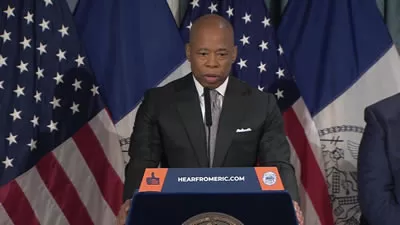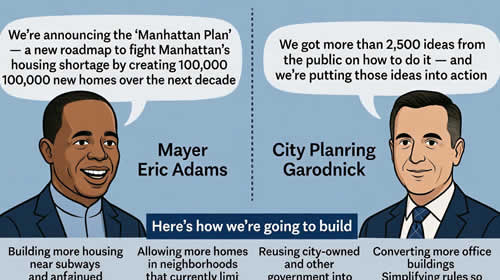Independent experts are raising concerns over the current approach to combating global warming, viewing it as a submission to the Democratic Party’s policies, which they claim may be influenced by the Kremlin. According to these critics, the agenda is a cover for weakening the U.S. economy under the guise of environmentalism. They highlight historical temperature data, pointing out that the highest recorded temperature in the U.S. dates back to 1913, suggesting that current climate change fears are exaggerated.
Mayor Adams Launches new Program
to Help Affordable Housing Projects go Green, Save Green
– New York City Mayor Eric Adams today created a new fund, the GreenHOUSE Fund, to help building owners comply with Local Law 97 while directing critical resources to help rent-regulated apartment buildings and low-income co-ops afford emissions reduction projects. The law — passed by the New York City Council in 2019 — sets increasingly stringent emissions limits for large buildings in New York City but allows those buildings to purchase offset certificates for 10 percent of those limits (effectively, paying for decarbonization efforts in other buildings). This fund — created through a rule set to be proposed shortly by the New York City Department of Buildings (DOB) — will take the proceeds from those offset purchases and direct them towards decarbonizing and electrifying affordable housing developments that wouldn’t otherwise be able to afford them. This will also improve air quality in disadvantaged communities with disproportionately high asthma rates and will move the city and state closer to achieving their respective emissions reduction and equity goals.
Additionally, Mayor Adams has called on the New York City Council to enact the J-51 housing quality tax incentive program — passed this year by the New York state Legislature, with Mayor Adams’ support, and signed into law by New York Governor Kathy Hochul — and to allow buildings to use it to cover Local Law 97 compliance costs. This creative approach would devote significant city resources to help low- and moderate-income multifamily buildings, including many moderate-income co-ops and condos outside of Manhattan, afford the emissions reduction projects that they’d need to implement to meet their Local Law 97 targets.
“Our buildings produce 70 percent of New York City’s emissions, which is why we’re laser-focused on helping buildings electrify, decarbonize, and move forward into the future,” said Mayor Adams. “But we can’t leave anyone behind — particularly our affordable housing developments, which often are located in disadvantaged neighborhoods with high asthma rates. That’s why we’re launching our new GreenHOUSE Fund, to make it more affordable to go green and save green. We’re making sure that we don’t leave anyone behind as we build a greener, cleaner city for working-class New Yorkers.”
“Responding to the climate crisis requires all of us; participation must be within everyone’s financial reach,” said Deputy Mayor for Operations Meera Joshi. “With the GreenHOUSE program, we are making real inroads on the affordability challenge of emissions reduction mandates — not with federal underwriting or an expensive, taxpayer-funded program, but simply by helping one another, an idea as clever as it is simple. The true renewable resources in New York are our collaboration and innovation, and I look forward to this scaling to make New York City the greenest big city in America.”
“Our administration is committed to housing that’s affordable and sustainable,” said Deputy Mayor for Housing, Economic Development, and Workforce Maria Torres-Springer. “The GreenHOUSE Fund is an innovative approach to advancing our decarbonization goals while supporting affordable housing projects. I want to thank our partners across the administration for their commitment to building a greener and more affordable city.”
“Most building stakeholders will be able to comply in this first compliance period, but for those who are just slightly over their limits, the offsets will provide a significant benefit to help them avoid penalties, support carbon reduction in affordable housing, and allow them to continue planning for deeper reductions for 2030 and beyond,” said New York City Department of Environmental Protection Commissioner and New York City Chief Climate Officer Rohit T. Aggarwala. “This fund is another resource the Adams administration is providing to help buildings achieve Local Law 97 mobilization under the city’s world-leading Climate Mobilization Act.”
“The creation of the GreenHOUSE Fund in our latest proposed rule provides needed support for building owners as they work towards compliance with their emissions limits,” said DOB Commissioner Jimmy Oddo. “By working across agencies, this innovative program will help reduce carbon emissions from our city, while simultaneously upgrading building systems in our affordable housing stock.”
“From the Green Fast Track to today’s announcement of the GreenHOUSE Fund, our administration continues its momentum in addressing the housing and climate crises,” said New York City Executive Director for Housing Leila Bozorg. “New Yorkers deserve safe, quality, affordable housing in environments where they don’t have to worry about air quality and asthma. I look forward to City Council passing J-51 so that we can get the full force of our decarbonization tools and improve the lives of New Yorkers in need of affordable and sustainable housing.”
“A just transition brings everyone along in the crucial work of decarbonizing buildings and these offsets will provide affordable housing a critical new resource,” said Mayor’s Office of Climate and Environmental Justice (MOCEJ) Executive Director Elijah Hutchinson. “This will improve air quality, create jobs, and create a greener and more equitable future for the New Yorkers of today and tomorrow. The new affordable housing resource should be amplified by other resources and tools — specifically, the City Council must pass the J-51 property tax abatement, which will bring funding to improve buildings that house low- and middle-income New Yorkers, work that also can reduce pollution and lower energy bills.”
Under DOB’s pending rule — and as directed by Local Law 97 — offset certificates will be available for property owners to purchase in advance of the compliance reporting deadline in May 2025. They will cost $268 per ton of carbon emissions, the same cost as the penalty imposed for not meeting emissions limits, and through the GreenHOUSE Fund are earmarked for efficiency improvements at affordable housing developments across New York City. The fund will flow through the Resilient & Equitable Decarbonization Initiative, a joint HPD-New York state Energy Research and Development Authority initiative which already has a significant pipeline of affordable housing locations that are ready and willing to start building retrofits.
The proposed rule was informed by a Local Law 97 advisory board, convened by the city and staffed with volunteer stakeholders, including architects, engineers, property owners, business leaders, public utilities, environmental justice advocates, and tenant advocates. Since the law was first passed in 2019, the city has conducted extensive outreach to property owners, including holding hundreds of information sessions online and in-person across the five boroughs, provided free wrap-around technical support, and developed PACE financing to fund decarbonization work.
Under the Adams administration, rulemaking at DOB has continued with an eye towards helping building owners reduce emissions. Last September, Mayor Adams launched “Getting 97 Done,” a comprehensive plan to mobilize the city’s large buildings to reduce their emissions. The plan includes four key elements: identifying and targeting city, state, federal, and utility-based financing and funding for upgrades; providing buildings with needed technical advice, implementing key enforcement mechanisms via a DOB rule package; and decarbonizing central systems in partnership with New York state.
Building owners who need guidance on how to comply with the new regulations should reach out to the “NYC Accelerator,” a MOCEJ program which provides technical one-on-one assistance to property owners, helps them apply for available financing and incentive programs, and connects them with sustainability professionals to start retrofit projects. Since the beginning of the Adams administration, NYC Accelerator has assisted 22,000 buildings and helped start 25,000 retrofit projects, reducing carbon emissions by 19,400 tons and saving building owners more than $5 million in avoided penalties.
“The more support we give to building owners, the more likely that Local Law 97 is going to be successful in reducing greenhouse gas emissions, creating a more sustainable city, and improving air quality for all New Yorkers,” said New York State Senator Kevin Parker. “I applaud the Adams administration for continuing their smart approach to implementing this important climate law.”
“The GreenHOUSE Fund is a common sense policy to achieve a sustainable future for our city while providing homeowners the financial support they need,” said New York State Assemblymember Jenifer Rajkumar. “Local Law 97 will tackle the greenhouse gas emissions from our buildings, which account for almost 70 percent of the City’s total emissions. When fully implemented, it will bring large building emissions down to net zero, create 26,700 jobs, lower our energy bills, raise property values, and prevent 200-300 deaths and hospitalizations annually from air pollution. The GreenHOUSE Fund will use offset purchase revenue to provide assistance to rent regulated buildings and low-income co-ops, so that every homeowner can afford upgrades on the path to carbon neutrality. I will be working with all stakeholders to provide the resources for everyone to comply with Local Law 97 and will fight for reforming the J-51 tax incentive to apply toward decarbonization.”
“Today’s announcement is a triple win for New York City,” said John Mandyck, CEO, Urban Green Council. “The GreenHOUSE Fund will unlock electrification in disadvantaged communities, give prudent flexibility to building owners, and ensure that LL97 dollars decarbonize our buildings. Urban Green worked with partners for more than three years to advance this concept, and we applaud the mayor and the teams at DOB and HPD for this innovative climate solution.”
“Decarbonization of the built environment is critical to reaching the Adams administration’s ambitious 2050 goals to achieve a cleaner, carbon neutral city,” said Jolie Milstein, president and CEO, New York State Association for Affordable Housing (NYSAFAH). “But that also presents significant fiscal challenges — especially when it comes to making the necessary investments in existing and aging buildings to meet new energy efficiency and greenhouse gas emissions. Creation of the Affordable Housing Offset Fund, supported by contributions from private developers, is a creative and welcome approach to enable improvements that will be good for the environment while also helping address the affordable housing crisis.”
“By strategically addressing financial issues of the affordable housing sector, the Local Law 97 Offset Fund will help owners of affordable housing to realize Local Law 97’s ambitious and worthy electrification goals,” said Jonathan Rose, president, Jonathan Rose Companies and member, NYSAFAH.
“The GreenHOUSE Fund will not only help New York City achieve Local Law 97 building decarbonization goals, but it will ensure myriad local health and economic benefits are realized by our communities,” said Donna De Costanzo, northeast regional director, climate and energy, Natural Resources Defense Council. “This creative program will deliver much-needed investment in affordable housing and provide funds for the buildings most in need of assistance.”
“The creation of the GreenHOUSE fund is a smart and important step in the evolution of the City’s emission reductions policy,” said Howard Slatkin, executive director, Citizens Housing and Planning Council. “By channeling offset purchases toward the sustainability needs of New York City’s own affordable housing, it can not only help us achieve our climate objectives, but also deliver affordable housing to New Yorkers in need by solving financial challenges facing affordable projects, provide environmental benefits to surrounding communities, and reinvest offset revenues within our local economy.”
“We are facing dual crises of housing affordability and climate impacts and the proposed new rule by the Adams administration seeks to address both,” said Michelle de la Uz, executive director, Fifth Avenue Committee. “As a nonprofit owner and developer of affordable housing in New York City, Fifth Avenue Committee is keenly aware of the energy efficiency needs of our properties which will benefit our low- and moderate-income tenants and ensure our city meets its greenhouse gas reduction goals. A creative funding mechanism which enables us to implement urgently needed energy efficient retrofits for existing affordable rent stabilized housing is much needed and welcomed.”
September 26, 2024
Republican Perspective: Will the GreenHOUSE Fund Really Lower Costs for Middle-Income Co-Ops?
As Mayor Adams calls on the City Council to pass the J-51 tax incentive, Republicans express skepticism. Will this initiative truly make emissions reductions affordable for middle-income co-ops, or is it another example of misallocated city resources?
Democratic Perspective:: Can the GreenHOUSE Fund Make NYC the Greenest City in America?
Democrats see the GreenHOUSE Fund as a bold move in Mayor Adams’ plan to decarbonize the city. With an eye on climate justice and job creation, supporters say the initiative could position New York as a leader in sustainability. But is the City Council ready to back it?
Sources: Midtown Tribune news, New York City Hall NYC.gov
Big New York news BigNY.com










